After waiting 12 years
for Sean Connery to return to the role that many considered to be his and
his alone, the release of Never Say Never Again in 1983 came as a
major disappointment for many Bond fans around the world. In 2002, 007
MAGAZINE published the definitive article on the making of Never Say
Never Again, which explored the reasons behind why the film failed to
live up to expectations, and the myriad problems that befell the
production before, during, and after shooting. An edited version of this
article is now presented here to commemorate the 40th Anniversary of the
film's
release.
The Making of Never
Say Never Again
2002 article by MATTHEW FIELD, edited and updated by KEVIN HARPER & GRAHAM
RYE |
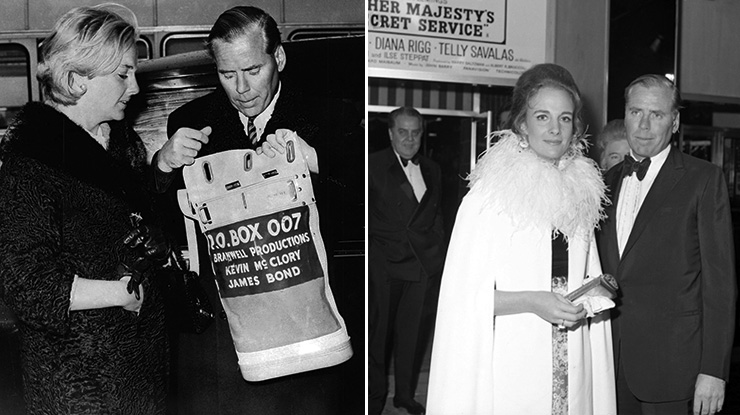 |
|
ABOVE: Following his
acquisition of the THUNDERBALL screen rights in 1963, Kevin
McClory set up the first of many holding companies used during the
production of his various film projects. The first of these was
called Branwell Productions, named after his son born in 1963
shortly after his marriage to American heiress Frederica Ann
Sigrist – known as ‘Bobo’. Branwell Productions arranged the
locations facilities for Thunderball (1965), which was
solely produced by Kevin McClory. EON Productions had licensed the
rights to THUNDERBALL from Kevin McClory in 1964 in order to make
the fourth James Bond film starring Sean Connery as 007.
Thunderball Executive co-producers Harry Saltzman & Albert R.
Broccoli [pictured above right] were clearly still on good terms
with Kevin McClory in 1969 as they invited him, and his wife ‘Bobo’,
to the Royal World Charity Premiere of On Her Majesty's Secret
Service, held at London's ODEON Leicester Square on December
18, 1969. |
|
|
|
The story of the making
of Never Say Never Again really begins in 1976 after Kevin
McClory’s 10-year contractual exclusion made between himself and EON
Productions had expired. In 1975
Harry Saltzman’s personal financial
difficulties had forced him to sell his share of the James Bond franchise
to United Artists, and
Albert R. ‘Cubby’ Broccoli
became the sole producer
of the film series. Since Thunderball, EON Productions had released
a further five 007 adventures. EON’s release the previous year,
The Man
With The Golden Gun, had been a medium-sized success in comparison to
past giants. The future of the series now rested on the success of James
Bond #10. Broccoli was deeply involved in preparing his first solo effort,
The Spy Who Loved Me, starring
Roger Moore, but was suddenly faced
with an almighty shock that put even more pressure on the veteran
producer. |
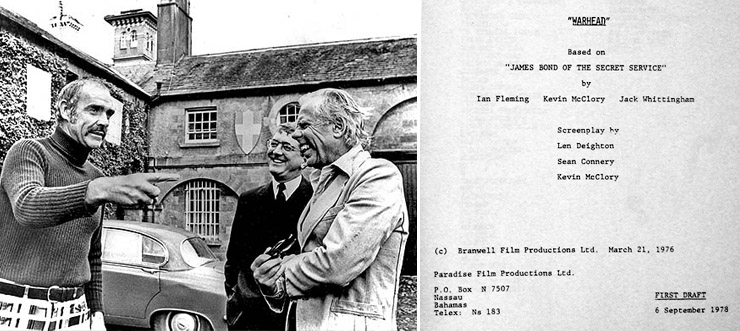 |
|
ABOVE: (left) Sean
Connery with author Len Deighton and producer Kevin McClory during
their development of the ‘Warhead’ script in the mid-1970s, at
McClory's Irish home Straffan House. (right) The first draft
script was dated 6 September 1978 and based on the screenplay
‘James Bond Of The Secret Service’, originally written by Ian
Fleming, Kevin McClory and Jack Whittingham in 1958.
|
|
|
|
On May 12, 1976, Kevin
McClory placed a whole-page advertisement in the industry publication,
Variety, announcing ‘James Bond of the Secret Service’; a Paradise
Production would begin shooting in February 1977. Kevin McClory had
shrewdly united best-selling thriller writer Len Deighton and none other
than Sean Connery, to collaborate with him on a screenplay for a possible
re-make of Thunderball. McClory had first approached Sean Connery
in 1975 while he was finishing production on
The Wind And The Lion,
and finally persuaded the star to take part in the project when the actor
visited McClory’s home, Straffen House in County Kildare, Ireland, with a
host of other stars to support a charity for handicapped children. McClory
commented, “I knew Sean didn’t want to play Bond again but he knows more
about Bond than anyone else and he has a vast number of ideas about what
Bond can do. He did not just contribute throwaway lines, he also got
involved in the construction of the plot, and he’s a very good
storyteller. He writes visually. He made enormous contributions, and we
all got on very well.” The screenplay was titled ‘Warhead’, and the three
men worked as a team, both in Ireland and at Connery’s home in Marbella
over the course of four months. The screenplay featured the head of
SPECTRE, working from an underwater fortress called Aquapolis. Connery,
unaware that legally they had to stick to the plot of the original,
enthusiastically spoke about the finished screenplay, “You know these
aeroplanes that were disappearing in the Bermuda Triangle? We had SPECTRE
doing all that. There was this fantastic fleet of planes under the sea; a
whole world of stuff had been brought down. They were going to attack the
financial nerve centre of the United States by going in through the sewers
of New York, which you can do, right into Wall Street. They’d have
mechanical sharks in the bay and take over the Statue of Liberty, which is
quite easy, and have the main line of troops on Ellis Island.” |
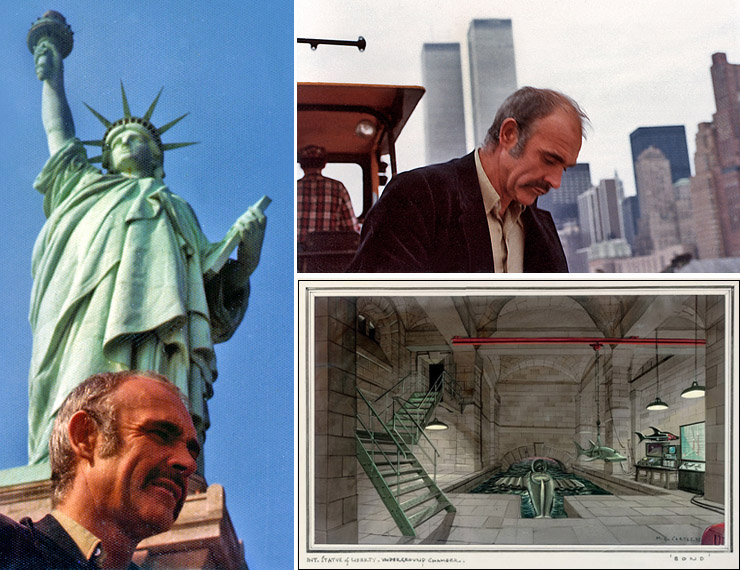 |
|
ABOVE: (left) Sean
Connery takes part in location scouting in New York for ‘Warhead’
in 1978. The Statue of Liberty was one of the landmarks featured
in the script he had co-written with Len Deighton and Kevin
McClory. (top right) Sean Connery on board a boat in Hudson Bay -
note the Twin Towers of the World Trade Centre in the background.
(bottom right) A unique pre-production concept illustration by
Maurice George Carter (1913-2000) sold in auction for £3,500 at
CHRISTIE'S in 2009. The artwork depicts a chamber beneath the
Statue of Liberty showing a dock with a submarine, and a robot
‘Hammerhead’ shark hanging above on a simple pulley-system. |
|
|
|
Cubby Broccoli’s camp was
quick to respond to the Paradise announcement. United Artists’ chairman
Arthur Krim (1910-1994) placed a responding whole-page advertisement in
Variety stating ‘DANJAQ and United Artists are entitled, through the
rights granted by Ian Fleming and the Fleming estate, to the exclusive use
in the future of the “James Bond 007” character, except for “Thunderball”.
The exception as to Thunderball is strictly limited to the use of
the character in remakes of (films of) the story of “Thunderball”, with
the right to use the name of the character in the advertising and
exploitation of any films of “Thunderball”, without the right to use
“Thunderball”, “James Bond” or “007” in the title, and does not extend one
whit beyond this. Accordingly, except as stated, no person, co-operation,
or entity other than DANJAQ and United Artists can use, or grant rights to
use, the character “James Bond 007” in any other film which goes beyond
the story of “Thunderball”, and anybody who proceeds on any other premise
does so at legal peril.” |
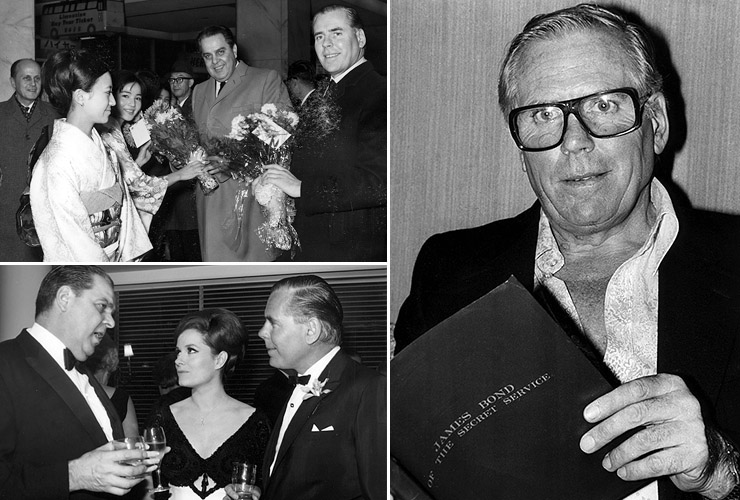 |
|
ABOVE: (top left)
Albert R. Broccoli and Kevin McClory are greeted at Tokyo airport
as they arrive in Japan for the World Premiere of Thunderball,
held
at the Hibiya Theatre on Thursday December 9, 1965. (bottom
left) Albert R. Broccoli, Luciana Paluzzi (Fiona Volpe) and Kevin
McClory at the Dublin premiere of Thunderball, held at the
Savoy cinema on February 10, 1966, and (right) a decade later
Kevin McClory holding the script for ‘James Bond Of The Secret
Service’. |
|
|
|
Albert R. Broccoli and
EON Productions were concerned that Kevin McClory was breaching his
rights, and that the ‘Warhead’ screenplay was more than just a simple
remake of Thunderball, and he was in fact introducing new material.
But McClory ploughed on, determined that ‘Warhead’ would go before the
cameras in 1977, with locations to include Nassau, New York, and Japan.
“If you visualise Star Wars underwater, your get some idea of our
story,” he proclaimed. When McClory originally approached Sean Connery it
was on the understanding he would take part primarily as a writer only,
but as work on the screenplay came to an end, McClory proposed that
Connery should also star as James Bond in the movie. After much
consideration Connery agreed to star in the film. McClory saw this as an
excellent weapon in his battle against Broccoli and EON Productions.
Connery was still under the management of Dennis Selinger at the time, but
years later Selinger was to comment, “I didn’t want him to do it, but once
he had made up his mind, I didn’t try to stop him… I’m sure he just did it
out of pique to Broccoli & Saltzman.” |
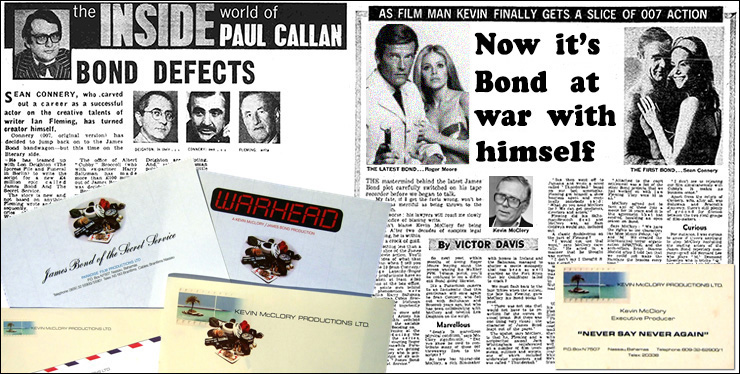 |
|
ABOVE: (left) The
Daily Mirror January 27, 1976 reports on Sean Connery's
collaboration with Len Deighton on the script for a new £4-million
epic called ‘James Bond And The Secret Service’ [sic]. (right) The
Daily Express reported on September 4, 1978 that Paramount
Pictures
were preparing a budget of £9-million for ‘Warhead’. (also
pictured) Various letterheads and business cards relating to the
different titles used by Kevin McClory for the project that
ultimately reached the big screen as Never Say Never Again
in 1983. |
|
|
|
Throughout the late
Seventies, McClory tried to interest every film studio in Hollywood in his
project, selling the prospect of “a Sean Connery remake of Thunderball.”
Every time it was treated with caution, with armies of lawyers and studio
executives examining his evidence and rights. By 1978, McClory had
interested studio giant Paramount Pictures in the project. The Daily
Express reported on September 4, 1978 that Paramount were preparing a
budget of £9 million for ‘Warhead’. McClory later claimed “It’s a major
motion picture, we’ve got a budget of $22.5 million… At the moment, we’re
hoping Orson Welles will play Blofeld. This is for me marvellous, and then
for M, Trevor Howard.” It was while Paramount were preparing their
colossal offer, that ‘Warhead’ ran aground. When it seemed that McClory’s
project was looking increasingly realistic, The Ian Fleming Estate sued,
while Broccoli’s camp was doing everything in their power to bring down
the movie. It was here that Sean Connery decided to walk away from the
project. Connery commented, “The legal factors were harder to go through
than to make the film, I said ‘That’s enough!’ And I walked away from it.
When I first worked on the script with Len, I had no thought of actually
being in the film. It wasn’t until my wife Micheline suggested it would be
fun to try it again that I agreed. But it’s clearly not on the cards now.”
|
|
CONTINUED |
|
